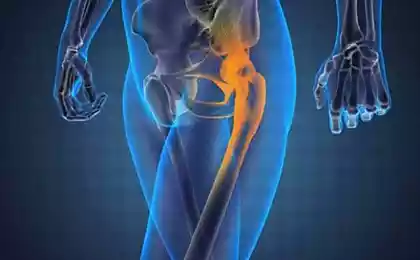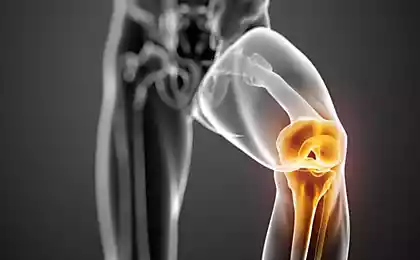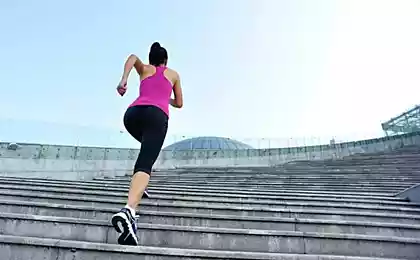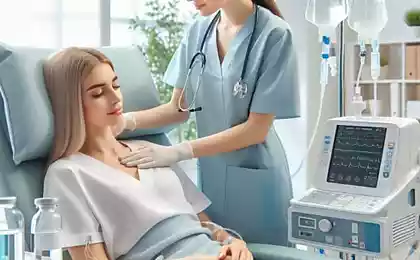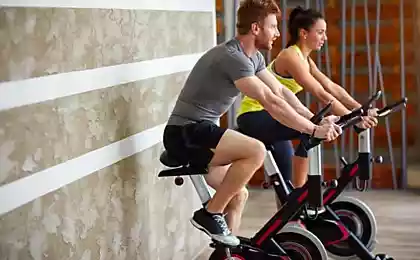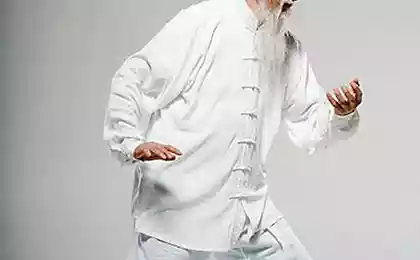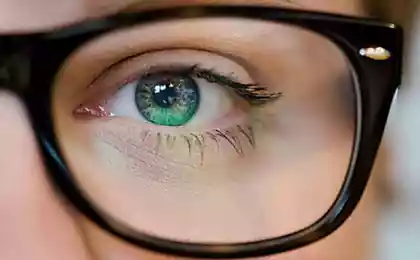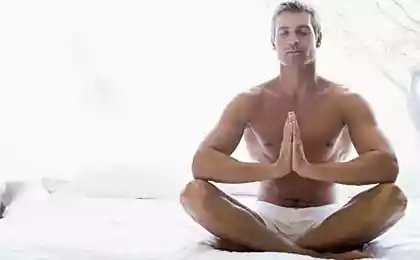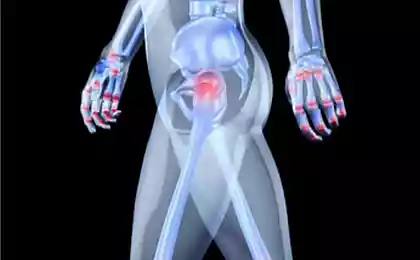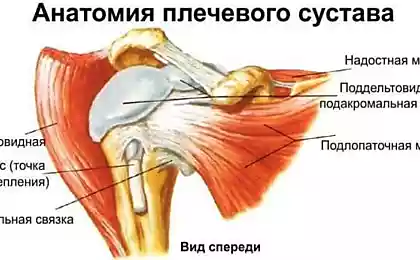191
How to help sick joints
Lack of movement leads to accelerated destruction of the diseased joint. But the same result leads to an increase in the amplitude of movement, and excessive load on the diseased joint. Therefore, rehabilitation exercises should be treated with great caution. None of them should give at least the slightest pain. If you feel pain, stop exercising immediately!
The following exercises are recommended to be performed at the initial stage of the disease - no higher than the 2nd degree.
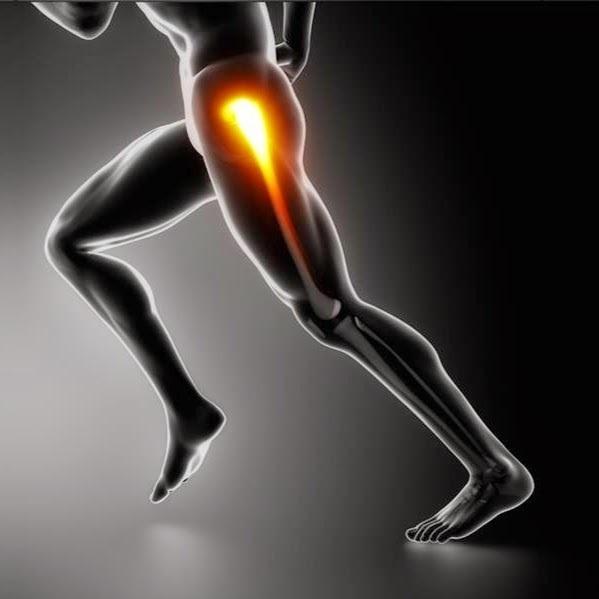
Exercise 1.It's done standing up. Stand with a healthy foot on a small elevation, while the patient should hang down as much as possible. Shake the sick foot forward and back and right and left. Be sure to stick to the support. It is desirable that the sick leg is on the opposite side of the support.
Exercise perform 2-3 times a day for 5-10 minutes. The amplitude is very small. No pain is allowed.
Exercise 2.It is designed for the weakest patients.
Make a loop from a wide belt or towel. Hang over the bed, in your legs, at a height of about 25 cm.
Lie down on the bed and insert the sore leg into the loop, approximately to the middle of the calf. Completely relax the leg and slightly sway it to the right and left or bend-extend in the knee.
Movements are performed with a minimum amplitude. Pain is unacceptable! The exercise can be performed for many hours every day.
Any degree of coxarthrosisExercise 1.It is better to perform the exercise on the floor, laying a mat or blanket, but you can also on the sofa. Lie on your stomach, put your hands under your head or stretch along your body. Under the feet, place a small pad or roller.
Attention! With severe coxarthrosis, it happens that the hip joints do not completely straighten. Then lying on your stomach and relaxing is impossible. In this case, a thick soft roller should be placed under the lower abdomen and groin. The thickness is selected individually, depending on the condition of the joints. If the knee joints are inflamed and swollen, pain is possible in them. In this case, you need to put something soft under your knees.
Relax as much as possible. When rolling on your stomach, slightly sway your hips to the right and left. The amplitude of movements should not exceed 2 cm. Do not strain the muscles, do not try to lift the pelvis.
When performing the exercise, it is necessary to find the optimal frequency of movements, find “resonance”. "Resonance" is found if the movement is performed as easily as possible, and as the frequency increases or decreases, the difficulty of execution increases dramatically. If you feel the slightest pain, reduce the amplitude of movements and try to relax; experimentally determine the most suitable distance between the heels.
The exercise is performed 3 times a day for 10 minutes (before meals). Weakened patients should start with 3-5 minutes 2 times a day.
When performing exercises in the hip joints there are rotational movements that improve their nutrition. But people who have been without normal motor load for a long time, even such a simple exercise is sometimes difficult to perform correctly. Therefore, it is advisable to do it first with the help of the operator.
The patient's posture is the same. The operator sits next to the patient, puts his hand on his buttocks and, slightly moving his hand forward - back, rolls the patient back and forth. All requirements are the same: the amplitude is not more than 2 cm, the patient is completely relaxed and, of course, the operator must also find the resonant frequency.
The beneficial effects of exercise are not limited to the joints. Its implementation contributes to the improvement of intestinal peristalsis, while the liver, gallbladder, stomach, pancreas and other organs are massaged. In heavy people, the stomach is tightened, waist volume decreases and appetite decreases. Diabetes is often relieved.
Exercise 1 can be performed even in the most severe forms of the disease, because the leg muscles are not involved, and movement in the joint is passive.
Exercise 2.It is done lying down or lying on your back. Extend and spread your legs a little. Put a small pillow under your knees. If the hip joint does not extend completely, increase the thickness of the pillow. Shift your knees 1 cm, then immediately extend to the starting position. If necessary, ask someone to monitor the amplitude of the movement.
This exercise can be done daily for hours. With pain, it is necessary to reduce the amplitude of movements, change the width of the legs and relax as much as possible.
Exercise 3.Performed sitting. It can be done at home, at work, in transport. Sit comfortably. The knees should be about the width of the shoulders, and the feet should stand tightly on the floor. Easily and without tension, move and spread your knees. The amplitude of movements is not more than 1 cm. At first, to control the amplitude of movements, it is better to keep your hands on your knees.
If you feel pain, put your legs a little narrower or wider, try to reduce the amplitude of movements, change their frequency, relax.
Exercise 4.Sit down, put your feet firmly on the floor. Choose a comfortable distance between your knees and between your feet. Relying on the sock, raise the heel of the sore leg by 1-2 cm and lower it back to the floor. Rest for 3-5 seconds and repeat the movement.
With proper execution, the heel should rise quickly, but without a sharp jerk, by short-term tension of the calf muscle. After lifting, the muscle should immediately relax, and the leg under the influence of its weight falls down. It is to fall, you can not lower the leg slowly, straining the calf muscle. Do not strain the muscles of the thigh for forced lowering of the leg. If both joints are affected, the movement should be performed alternately, maintaining a pause of the same duration.
Total exercise time is 3 to 10 or more hours a day in severe cases.
As you can see, all exercises are very light and close in their action. Which one to do depends on your ability and desire.
Now we need to activate blood circulation in the affected area, restore the elasticity of the adjacent tendons, the elasticity of the joint bag and provide conditions for joint regeneration. To do this, a chiropractor, a chiropractor or someone from the patient’s friends or relatives is needed. According to some experts, a favorable circumstance is the direct impact on the joint of the biofield of the hands.
Procedure 1.It begins with tapping on the upper posterior edge of the ilium (approximately the lower lumbar border). In this place there is a large nerve, usually inflamed with coxarthrosis. The taps are made on tightly pressed fingers. With such a press, blood is squeezed out of the capillaries, bruising does not occur, and the energy of the impact penetrates to deep structures.
The stronger the inflammation, the easier and weaker the strokes should be. Pain is slightly below average. At the end, to cause a rush of blood, a few strong slaps are applied with the palm.
The procedure relieves inflammation of the nerve, activates regenerative processes in the joint.
Procedure 2.It is carried out in the area of the hip head. Blows are applied through the fingers, strong enough, but so as not to cause excessive pain.
With regular performance, joint mobility increases, its nutrition improves, painful sensations decrease. The procedure also ends with vigorous slaps.
Procedure 3.The hand is placed on the thigh in front, just below the groin and pressed strongly. Energetic but careful blows are applied with the wrist or rib of the palm through the hand. Slaps are not recommended.
Procedure 4.Knocks are made at the back of the thigh, just below the buttock fold. It ends in spanking.
Indicators of proper procedures are a complete absence of bruises, bruises, pain and slight redness of the skin immediately after the session. A slight increase in joint pain is allowed the day after the procedure.
How often should procedures be performed?
Usually they are performed 1 time a week, the course is 8-10 sessions. Then - about 1 time per month, according to the testimony. In the most severe cases, accompanied by severe inflammation or swelling -1 times in 10-14 days. Then, with the relief of the disease, according to the previous scheme.
Such simple techniques have helped many patients. And experience has shown that coxarthrosis can be treated without surgery. published
Written by Gitt Vitaly Demjanovich, chiropractor
P.S. And remember, just changing our consumption – together we change the world!
Source: www.gitt.ru/articles/bud_zdorov/kak_pomoch_sustavam/
The following exercises are recommended to be performed at the initial stage of the disease - no higher than the 2nd degree.

Exercise 1.It's done standing up. Stand with a healthy foot on a small elevation, while the patient should hang down as much as possible. Shake the sick foot forward and back and right and left. Be sure to stick to the support. It is desirable that the sick leg is on the opposite side of the support.
Exercise perform 2-3 times a day for 5-10 minutes. The amplitude is very small. No pain is allowed.
Exercise 2.It is designed for the weakest patients.
Make a loop from a wide belt or towel. Hang over the bed, in your legs, at a height of about 25 cm.
Lie down on the bed and insert the sore leg into the loop, approximately to the middle of the calf. Completely relax the leg and slightly sway it to the right and left or bend-extend in the knee.
Movements are performed with a minimum amplitude. Pain is unacceptable! The exercise can be performed for many hours every day.
Any degree of coxarthrosisExercise 1.It is better to perform the exercise on the floor, laying a mat or blanket, but you can also on the sofa. Lie on your stomach, put your hands under your head or stretch along your body. Under the feet, place a small pad or roller.
Attention! With severe coxarthrosis, it happens that the hip joints do not completely straighten. Then lying on your stomach and relaxing is impossible. In this case, a thick soft roller should be placed under the lower abdomen and groin. The thickness is selected individually, depending on the condition of the joints. If the knee joints are inflamed and swollen, pain is possible in them. In this case, you need to put something soft under your knees.
Relax as much as possible. When rolling on your stomach, slightly sway your hips to the right and left. The amplitude of movements should not exceed 2 cm. Do not strain the muscles, do not try to lift the pelvis.
When performing the exercise, it is necessary to find the optimal frequency of movements, find “resonance”. "Resonance" is found if the movement is performed as easily as possible, and as the frequency increases or decreases, the difficulty of execution increases dramatically. If you feel the slightest pain, reduce the amplitude of movements and try to relax; experimentally determine the most suitable distance between the heels.
The exercise is performed 3 times a day for 10 minutes (before meals). Weakened patients should start with 3-5 minutes 2 times a day.
When performing exercises in the hip joints there are rotational movements that improve their nutrition. But people who have been without normal motor load for a long time, even such a simple exercise is sometimes difficult to perform correctly. Therefore, it is advisable to do it first with the help of the operator.
The patient's posture is the same. The operator sits next to the patient, puts his hand on his buttocks and, slightly moving his hand forward - back, rolls the patient back and forth. All requirements are the same: the amplitude is not more than 2 cm, the patient is completely relaxed and, of course, the operator must also find the resonant frequency.
The beneficial effects of exercise are not limited to the joints. Its implementation contributes to the improvement of intestinal peristalsis, while the liver, gallbladder, stomach, pancreas and other organs are massaged. In heavy people, the stomach is tightened, waist volume decreases and appetite decreases. Diabetes is often relieved.
Exercise 1 can be performed even in the most severe forms of the disease, because the leg muscles are not involved, and movement in the joint is passive.
Exercise 2.It is done lying down or lying on your back. Extend and spread your legs a little. Put a small pillow under your knees. If the hip joint does not extend completely, increase the thickness of the pillow. Shift your knees 1 cm, then immediately extend to the starting position. If necessary, ask someone to monitor the amplitude of the movement.
This exercise can be done daily for hours. With pain, it is necessary to reduce the amplitude of movements, change the width of the legs and relax as much as possible.
Exercise 3.Performed sitting. It can be done at home, at work, in transport. Sit comfortably. The knees should be about the width of the shoulders, and the feet should stand tightly on the floor. Easily and without tension, move and spread your knees. The amplitude of movements is not more than 1 cm. At first, to control the amplitude of movements, it is better to keep your hands on your knees.
If you feel pain, put your legs a little narrower or wider, try to reduce the amplitude of movements, change their frequency, relax.
Exercise 4.Sit down, put your feet firmly on the floor. Choose a comfortable distance between your knees and between your feet. Relying on the sock, raise the heel of the sore leg by 1-2 cm and lower it back to the floor. Rest for 3-5 seconds and repeat the movement.
With proper execution, the heel should rise quickly, but without a sharp jerk, by short-term tension of the calf muscle. After lifting, the muscle should immediately relax, and the leg under the influence of its weight falls down. It is to fall, you can not lower the leg slowly, straining the calf muscle. Do not strain the muscles of the thigh for forced lowering of the leg. If both joints are affected, the movement should be performed alternately, maintaining a pause of the same duration.
Total exercise time is 3 to 10 or more hours a day in severe cases.
As you can see, all exercises are very light and close in their action. Which one to do depends on your ability and desire.
Now we need to activate blood circulation in the affected area, restore the elasticity of the adjacent tendons, the elasticity of the joint bag and provide conditions for joint regeneration. To do this, a chiropractor, a chiropractor or someone from the patient’s friends or relatives is needed. According to some experts, a favorable circumstance is the direct impact on the joint of the biofield of the hands.
Procedure 1.It begins with tapping on the upper posterior edge of the ilium (approximately the lower lumbar border). In this place there is a large nerve, usually inflamed with coxarthrosis. The taps are made on tightly pressed fingers. With such a press, blood is squeezed out of the capillaries, bruising does not occur, and the energy of the impact penetrates to deep structures.
The stronger the inflammation, the easier and weaker the strokes should be. Pain is slightly below average. At the end, to cause a rush of blood, a few strong slaps are applied with the palm.
The procedure relieves inflammation of the nerve, activates regenerative processes in the joint.
Procedure 2.It is carried out in the area of the hip head. Blows are applied through the fingers, strong enough, but so as not to cause excessive pain.
With regular performance, joint mobility increases, its nutrition improves, painful sensations decrease. The procedure also ends with vigorous slaps.
Procedure 3.The hand is placed on the thigh in front, just below the groin and pressed strongly. Energetic but careful blows are applied with the wrist or rib of the palm through the hand. Slaps are not recommended.
Procedure 4.Knocks are made at the back of the thigh, just below the buttock fold. It ends in spanking.
Indicators of proper procedures are a complete absence of bruises, bruises, pain and slight redness of the skin immediately after the session. A slight increase in joint pain is allowed the day after the procedure.
How often should procedures be performed?
Usually they are performed 1 time a week, the course is 8-10 sessions. Then - about 1 time per month, according to the testimony. In the most severe cases, accompanied by severe inflammation or swelling -1 times in 10-14 days. Then, with the relief of the disease, according to the previous scheme.
Such simple techniques have helped many patients. And experience has shown that coxarthrosis can be treated without surgery. published
Written by Gitt Vitaly Demjanovich, chiropractor
P.S. And remember, just changing our consumption – together we change the world!
Source: www.gitt.ru/articles/bud_zdorov/kak_pomoch_sustavam/
